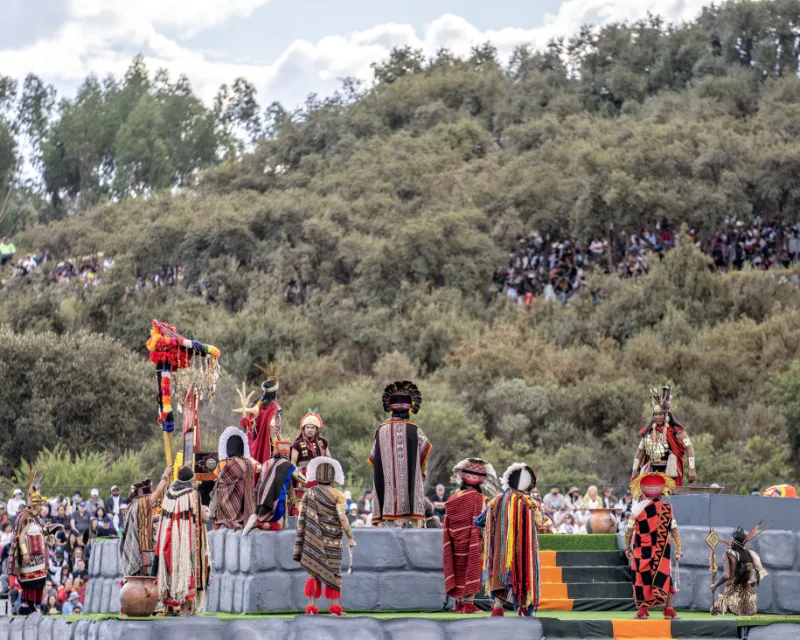Inti Raymi – The Festival of the Sun in Cusco
The traditional Inca festival of Inti Raymi (Festival of the Sun) is the most important in Cusco and Peruvian culture. This commemoration recalls the legacy of the ancient Inca empire, allowing us to appreciate the fervor, beliefs, and grandeur of this ancient culture. On June 24th, the entire city seems to come to a standstill to appreciate this ceremony, which takes place at three main epicenters (El Qoricancha, the Plaza de Armas, and the Sacsayhuamán Fortress). Learn more about this legendary festival so you don’t miss a single detail during your visit to Cusco.
Content:
- What is Inti Raymi?
- History of Inti Raymi
- When is Inti Raymi celebrated?
- The Inti Raymi in the Qoricancha
- The Inti Raymi in the Plaza de Armas
- The Inti Raymi in the Sacsayhuaman fortress
- Additional information about Inti Raymi – The Festival of the Sun
- Main rituals of Inti Raymi
- The Sacrifice of the Llama at Inti Raymi
- Tips for your visit to Inti Raymi
- Frequently asked questions about Inti Raymi
What is Inti Raymi?
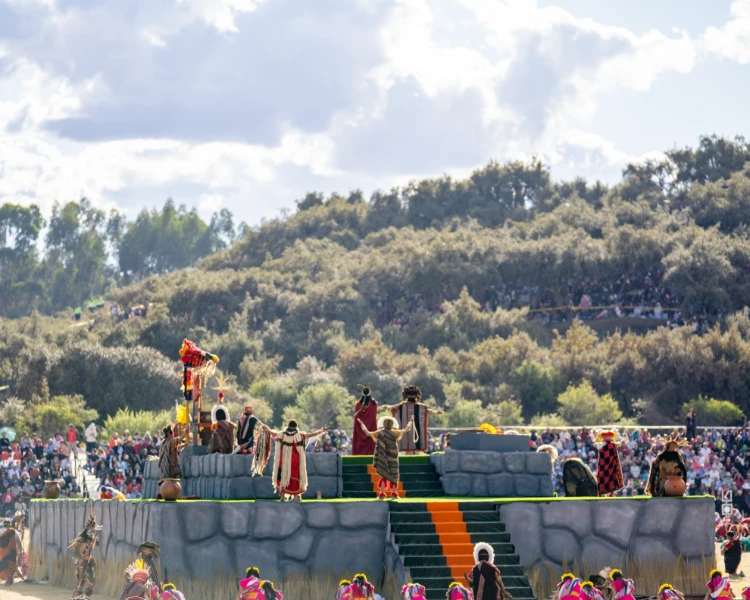
Inti Raymi carries with it a wealth of history and tradition dating back to the time of the Inca Empire and probably long before.
It was the most important ceremony of the Inca culture, where homage was paid to the Sun God, who was considered the most important deity.
Today it is celebrated every June 24th, alluding to the beginning of the winter solstice, the primordial harvest season when the Inca prayed to the Sun for continued prosperity and abundance.
Inti Raymi means: Inti – God and Raymi – Sun. Allowing us to imagine how much fervor they had towards this deity, and how she guided and blessed them throughout the season.
The Inti Raymi in Sacsayhuamán
Don’t miss the opportunity to experience one of Cusco’s most iconic festivals. Reserve your tickets for the main show at Sacsayhuamán through our website to secure your spot at this unique event. The celebration can be viewed from three grandstands: the red zone, the green zone, and the orange zone, each offering different perspectives and views from which to enjoy the impressive ritual. Take advantage of this opportunity to be part of the ancient Inca tradition of Inti Raymi and experience the connection from the Qoricancha, the Plaza de Armas, and the Sacsayhuamán fortress up close!
History of Inti Raymi
The Inca and Andean cultures were animistic, worshipping gods such as Viracocha (creator), Pachamama (mother earth), Apus (spirits of the mountains), and Mama Quilla (the moon). But among them all, the Sun God was the most venerated.
Inti (the Sun) played a prominent role in Inca culture. Although each inhabitant was allowed to possess their own gods, the greatest devotion was given to the Sun, who dictated the prosperity or decline of the people.
The festival spread throughout the Tahuantinsuyo (today regions within Peru, Bolivia, Ecuador, Colombia and Argentina) causing the entire empire to gather to celebrate and pay homage to the Sun.
During the celebration, beyond prayers for prosperity and blessings, sacrifices and offerings were made to maintain balance. This symbolized gratitude for the fertility of the land and good fortune that the sun god bestowed upon the Inca people.
During the Inca Empire, Inti Raymi lasted for almost 15 days, a time during which the Inca people were moved by this festivity. Inti Raymi currently lasts one day, but it will be enough to make your trip to Cusco a unique experience.
When is Inti Raymi celebrated?
Inti Raymi is celebrated annually on June 24th throughout Cusco and the Andean regions, coinciding with the beginning of the winter solstice, harvest season. In Inca times, this festival took place throughout the Tahuantinsuyo (Peru, Ecuador, Chile, Argentina, and Colombia). The festival commemorates the glorification of the sun god, seeking prosperity for the lands and its people for another season, offering and sacrifices to maintain a balance between the sun and the Inca population.
The Inti Raymi in the Qoricancha
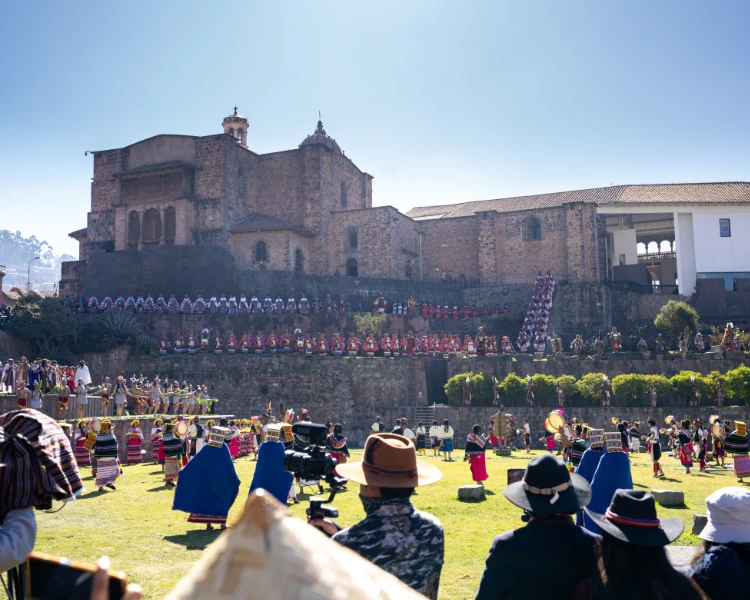
The Festival of the Sun, on June 24, takes place first and foremost at the mystical Temple of Qoricancha in Cusco.
Today, it is also known as the Convent of Santo Domingo, a church built on the foundations of the Qoricancha. The Spanish, as with all the most important Inca buildings in Cusco, built churches on top of Inca palaces and temples as a cultural imposition.
Qoricancha, a Quechua name meaning “Place of Gold,” served as a temple to worship the Sun God in Inca times, underscoring its great importance today as the primary setting for the Inti Raymi festival.
The ceremony begins around 9 a.m. It’s a free show for all attendees, so you should arrive early to get a good seat.
First, the Inca appears in possession of his scepter of power, addressing his entire people and entourage in the opening speech of the Festival of the Sun. The Inca takes chicha and coca leaves as offerings, commemorating the beginning of the ceremony in style.
The show is accompanied by approximately 300 actors and actresses who play roles such as the coya (wife), the high priest (who leads the ceremony), the army and the inhabitants of the four regions of Tahuantinsuyo: Chinchaysuyo, Antisuyo, Collasuyo and Contisuyo.
Finally, after 45 minutes of spectacle, the Inca and his entire entourage are transferred to the Plaza de Armas in Cusco, where the second Inti Raymi spectacle will take place at 11 a.m.
The Inti Raymi in the Plaza de Armas
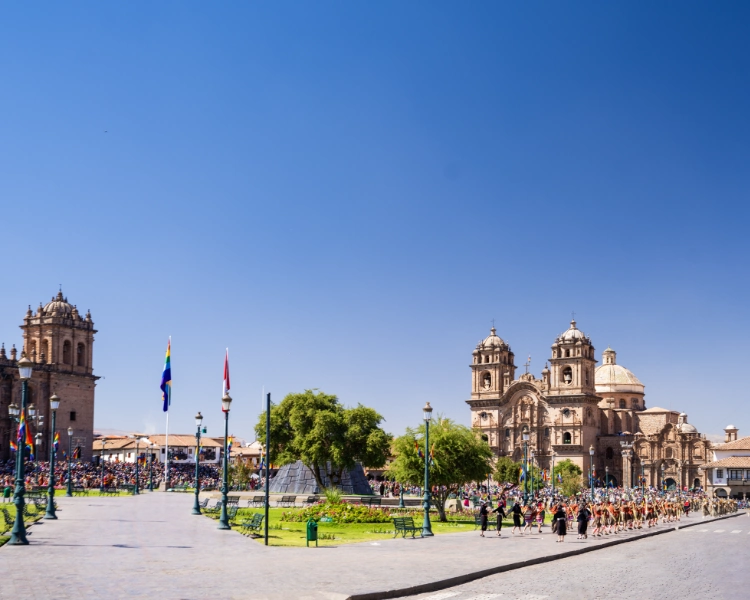
After the Inti Raymi celebrations at Qoricancha, the Inca is carried on a stretcher through the city’s main streets, accompanied by his entourage amid music and dance.
The Plaza de Armas is the central meeting point for Cusco’s citizens, framing one of the most beautiful places one will find.
During the Inca period, this plaza was called Huacaypata, and, as it is today, was considered a very important meeting place. During the colonial era, the Kiswarcancha, the palace of the Inca governor Huiracocha, was destroyed to construct the Cathedral.
Admission to this second Inti Raymi ceremony is also free, so plan your time to secure a comfortable spot and fully appreciate the magnanimity of the celebration.
The first great enigmatic staging begins at 11 a.m. with the entrance of the coya, the Inca’s wife, who is carried on a stretcher accompanied by her retinue of ñustas (princesses) and aqllas (virgins of the sun).
The nobility and the Inca then enter. Everyone parades around the Plaza de Armas, accompanied by dances and songs from representatives of the four corners of the Tahuantinsuyu empire, who carry offerings from each of the regions to which they belong. The performance is accompanied by Quechua music reminiscent of the Inca era.
Finally, the Inca heads to the main altar where the coca leaf reading ceremony takes place, where the high priest interprets the will of the Sun God. The ceremony lasts about 45 minutes.
After the prediction of good fortune, everyone gathers to begin the journey to the Sacsayhuamán fortress, where the main and final act will take place.
The Inti Raymi in the Sacsayhuaman fortress
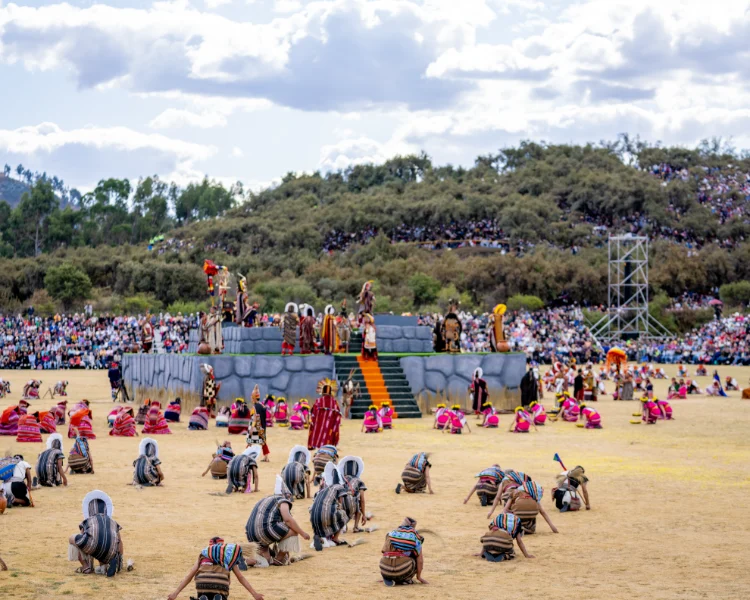
Just minutes from the Plaza de Armas, the Sacsayhuamán fortress serves as a unique archaeological destination in the city of Cusco, highlighted by its impressive walls that inspire you to understand the grandeur of the Inca culture. Spread across a vast territory, you’ll find enigmatic sites steeped in history, as well as panoramic, natural, and recreational areas.
During the colonial era, many of Sacsayhuamán’s walls were destroyed. It is estimated that today the archaeological site only shows 20 percent of its original form. Even so, this remains equally astonishing.
Sacsayhuamán is the main stage of Inti Raymi. Accompanied by hundreds of actors, it begins around 2:00 p.m. and lasts almost 2 hours and 30 minutes.
The ceremony can be clearly seen from three stands, which you must reserve in advance. These are divided into three types of tickets (red stand, green stand, and orange stand). Learn about Inti Raymi ticket availability.
The show begins with the appearance of the sinchi (Inca guard). He inspects the site, announcing that the Inti Raymi can now begin. Then, the emissaries from the four regions of Tahuantinsuyo enter amid a grand display of dance and music. From every angle of the walls of Sacsayhuamán, the Virgins of the Sun can be seen dancing to announce the arrival of the Inca.
The Inca’s entrance onto the main stage can be seen amid the jubilation of the Inca people. The attire, accompanied by color and fervor, seems to transport us back to the earliest days of this celebration; the aura of the festival is completely mystical.
At one of the ceremony’s climaxes, the Inca, accompanied by the high priest, performs a reenactment of the sacrifice of a black llama, which was considered sacred to the Incas. This spectacle is held in honor of the Sun God, who is venerated not only with prayers but also with offerings from each of the regions of Tahuantinsuyu, as well as the llama itself.
In this way, homage is paid to the sun god during Inti Raymi, filled with celebration, music, dance, color, tributes, and sermons that touch upon and carry with them centuries of history.
Additional information about Inti Raymi – The Festival of the Sun
| Aspect | Description |
|---|---|
| Origin of Inti Raymi | The Inti Raymi ceremony is believed to have been established by the Inca Pachacútec in the 15th century as the most important festival in the Inca Empire’s calendar. The ceremony was intended to thank the Sun God (Inti) for the harvests and the well-being of his people. |
| Symbolic Meaning | It represents the Inca connection with nature and the gods, offering them sacrifices and offerings as the gods do with them. |
| Original celebration | In Inca times, Inti Raymi lasted almost 15 days, with dances, ceremonies, and sacrifices in honor of the Sun. Today, the celebration has been reduced to a single day. |
| Colonial transformation | During the colonial period, Inti Raymi was banned by the Spanish in an attempt to eradicate indigenous traditions. However, the festival remained alive in the memories of many residents and was officially revived in 1944. |
| Modern recreation | The current Inti Raymi performance is a staging that combines history, theater, and tradition. It takes place in three locations: the Qoricancha, the Plaza de Armas, and Sacsayhuamán, with hundreds of actors in traditional costumes. |
| Traditional clothing | The Inca and his entourage wear colorful attire with feathers, gold embroidery, and fine fabrics. Traditional garments such as the unku (Inca tunic) and the mascaypacha (royal crown) are worn. Representatives of the four suya wear garments appropriate to the region they represent: Chinchaysuyo (North and Mountains), Antisuyo (Northeast), Collasuyo (Southeast), Cuntisuyo (Southwest). |
| Dances and music | During the ceremony, traditional dances from the four regions of Tahuantinsuyo are performed, accompanied by Quechua music played with native instruments such as quenas, zampoñas, and pututus (sea shells). |
| Offerings at the ceremony | The main offerings include coca leaves, chicha de jora, corn, textiles, the black llama, and gold and silver figures, all representing gratitude to the Sun God. |
Main rituals of Inti Raymi
- Sacred Fire Rite at Inti Raymi: This ritual consists of lighting a fire with the reflection of a bracelet in a container, symbolizing with its flame the trust and protection of the Inca and his people.
- Chicha Rite: In this ritual, the Inca takes a golden cup filled with sacred chicha and offers it to the Sun God as a token of gratitude. He then pours the contents into a trough that will carry the liquid to the Qoricancha. He then takes a silver cup, also filled with chicha, offers it to the sun, and drinks. He then invites his entourage to share from the same cup, allowing them to participate in the ritual.
- Sacrifice of the llama (representation): In this ceremony a llama is chosen and led to the sacrificial table, the priest opens its entrails and extracts the heart along with the lungs, so that predictions for the future of the Tahuantinsuyo can be observed in them.
- Sankhu Rite (Sacred Bread): The priests present sankhu baskets, small corn rolls. The high priest blesses them with the blood of the sacrificed llama, then asks the Inca to serve himself a portion of this sacred food. In this way, the fast that everyone has been following for three days in preparation for this Inti Raymi is broken.
- Coca leaf ritual: In this ceremony, coca leaves are read to gain insights into the future and the potential for prosperity and health for the empire.
The Sacrifice of the Llama at Inti Raymi
During Inti Raymi, one of the most significant and pivotal moments is the sacrifice of the llama. The llama must be black, as a symbol of purity; this animal was selected for its believed connection to the gods. This sacrifice is performed in honor of the Sun God, with the purpose of ensuring a season of good harvests and the well-being of the entire empire.
This reenactment takes place during the main Inti Raymi performance in Sacsayhuamán, where the Inca high priest (Willaq Uma) was in charge of performing the sacrifice in the presence of the Inca, priests, nobles, and the people. With a ceremonial knife (Tumi), he opens the llama’s chest and extracts its heart and organs. In the performance, these are used to read and interpret the future of the Tahuantinsuyu empire with omens. If these organs were healthy, it meant prosperity; if they were not, it was a bad sign.
Later, the llama’s blood was spilled on the earth in honor of Pachamama (Mother Earth), and all the meat was burned in honor of the Sun God. During the ceremony, each offering was a way of maintaining the balance between the gods and the people.
Today everything is a symbolic recreation, but faithful to what it was in the times of the Inca Empire.
Tips for your visit to Inti Raymi
- Arrive early at each of the performance venues so you don’t miss any of the party’s details.
- Come prepared with plenty of water, some snacks, sunscreen, and a hat, since Cusco tends to have high temperatures during these times.
- The entire celebration is conducted in Quechua, so having a guide will enrich your experience during the Festival of the Sun.
- Consider booking a tour to enjoy the show without any hassle from privileged locations.
- Keep your mind open because much of what you see will seem to take you back to the time of the Incas, full of mysticism.
- If you don’t reserve a seat on the Sacsayhuamán esplanade, you can opt to go to adjacent peaks to watch the spectacle, but from poor, distant positions.
- You can reserve a spot at the opening ceremony at the Qoricancha. Ask our advisors about all the options available to you to fully experience every detail of the festivities.
- Purchase your ticket for the main Inti Raymi show in Sacsayhuamán through our website. Remember, they sell out quickly. This is your chance to experience the most important Inca festival.
